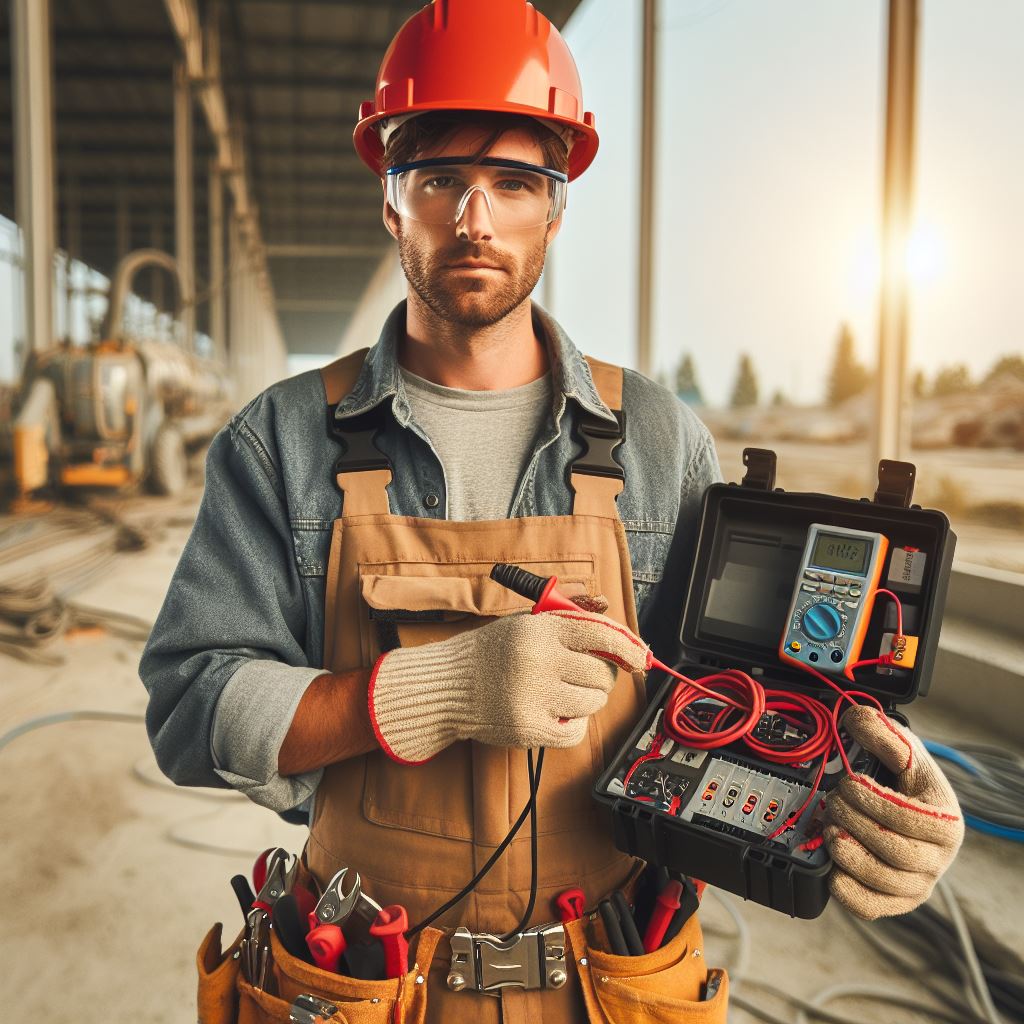Introduction
Safety protocols for electricians in Canada are of utmost importance in ensuring their well-being and preventing accidents.
These protocols serve as guidelines for identifying and minimizing potential hazards, making the work environment safer for both the electricians and those around them.
Importance of safety protocols for electricians in Canada
Adhering to these protocols is crucial to prevent injuries, electrocutions, fires, and property damages.
Purpose of the blog post
The purpose of this blog post is to enlighten electricians and anyone interested in electrical work on the significance of safety protocols.
It will provide a comprehensive overview of the key safety measures that electricians should follow in Canada.
By understanding and following these protocols, electricians can ensure their own safety and the safety of others.
Moreover, it enables them to comply with the legal requirements set by Canadian regulatory bodies, such as the Canadian Electrical Code (CEC) and Occupational Health and Safety (OHS) Regulations.
Throughout this blog post, we will explore various safety protocols, including personal protective equipment (PPE), proper handling of electrical equipment, and safe work practices.
By emphasizing the importance of safety protocols and providing practical guidance, this blog post aims to create awareness and promote a culture of safety among electricians in Canada.
Stay tuned for valuable insights and tips to prioritize safety in your electrical work. Let’s work together towards a safer future!
Overview of Electrical Work in Canada
In Canada, electrical work is a critical profession that plays a pivotal role in various industries.
Electricians are responsible for installing, maintaining, and repairing electrical systems in homes, commercial buildings, and industrial settings.
They work with a wide range of electrical equipment, such as wiring, transformers, circuit breakers, and control systems.
Electricians in Canada also handle more specialized tasks, including setting up power distribution systems, troubleshooting electrical issues, and ensuring compliance with safety regulations.
Their expertise is crucial in ensuring a safe and efficient electrical infrastructure for daily operations across the country.
Types of Electrical Work Performed in Canada
Electrical work in Canada covers a diverse range of activities that require specialized knowledge and skills.
Industrial electricians, for example, focus on electrical systems used in manufacturing plants, power plants, and other industrial facilities.
Residential electricians, on the other hand, primarily work on electrical systems within homes and apartment buildings.
Commercial electricians specialize in electrical installations and maintenance for businesses, offices, and retail spaces.
Other specialized areas include marine electricians, who deal with electrical systems on ships and boats, and powerline technicians who work on overhead or underground power lines.
Regardless of the specific field, electricians in Canada share common risks and hazards associated with their profession.
Potential Risks and Hazards in Electrical Work
Electrical work involves inherent risks that can result in injuries or even fatalities if proper safety precautions are not followed.
Electricians are exposed to the dangers of shocks, burns, and electrical fires due to direct contact with live electrical components.
Working at heights, such as when installing light fixtures or working on rooftops, poses a risk of falls.
Inadequate personal protective equipment and improperly maintained tools can increase the likelihood of accidents and injuries.
Unlock Your Career Potential
Visualize a clear path to success with our tailored Career Consulting service. Personalized insights in just 1-3 days.
Get StartedExposure to hazardous substances like asbestos and lead, commonly found in older electrical systems, is another concern.
In addition, electricians face the risk of encountering unexpected wiring faults or encountering hazardous situations during their work.
The Importance of Safety Protocols
Given the potential risks involved, safety protocols are crucial for electricians to ensure their well-being and the safety of others.
Compliance with established safety protocols minimizes the likelihood of accidents and promotes a culture of safety within the profession.
Electricians must follow key practices such as identifying electrical hazards, using proper personal protective equipment, and maintaining a safe working distance from live electrical components.
Regular training and certification updates are vital to staying updated on the latest safety standards and work practices.
Communication and teamwork also play essential roles in promoting safety, as electricians often work alongside other professionals in construction or maintenance projects.
By adhering to safety protocols, electricians can perform their tasks effectively while minimizing the risk of accidents and injuries.
Summarily, Electrical work in Canada encompasses various specialized fields, with each carrying unique risks and hazards.
Safety protocols are indispensable for electricians to ensure their safety and the well-being of others.
By prioritizing safe work practices, electricians contribute to maintaining a reliable and secure electrical infrastructure across the country.
Continuous training and staying updated on safety standards are essential for a successful career in this critical profession.
Read: 2024 Trends in the Electrical Industry in Canada
Canadian electrical safety regulations and standards
When it comes to electrical work in Canada, safety is of paramount importance.
Electricians in Canada are required to adhere to a set of strict regulations and standards.
- The Canadian Electrical Code is the national standard for electrical installations, ensuring safety and compliance.
- Provincial and territorial regulations also govern electrical work, adding specific requirements and guidelines.
- These regulations cover various aspects like installation, wiring, grounding, and use of electrical equipment.
- They help prevent electrical hazards, protect workers, and ensure the safety of the general public.
Relevant regulations and standards for electricians in Canada
Electricians must closely follow the relevant regulations and standards to ensure safety and compliance.
- Proper grounding and bonding methods are crucial to prevent electrical shocks and fires.
- Working with live electricity requires the use of appropriate personal protective equipment (PPE).
- Ensuring proper insulation and protection against electrical arcing minimizes the risk of accidents.
- Following safe work practices, such as Lockout/Tagout procedures, prevents unexpected energy release.
- Adhering to clearances and installation requirements helps avoid contact with live parts.
The role of organizations like the Canadian Standards Association (CSA)
The Canadian Standards Association (CSA) plays a vital role in electrical safety in Canada.
The CSA develops and maintains electrical standards to promote safe installation practices.
These standards cover a wide range of electrical products, equipment, and installation methods.
CSA certification ensures that electrical products meet the necessary safety requirements.
The importance of staying up to date with the latest regulations and standards
Electricians must remain up to date with the latest regulations and standards to ensure workplace safety.
Regular training and continuing education programs help electricians stay informed about changes and updates.
Advancements in technology and electrical systems call for staying current with emerging safety practices.
Following the latest regulations and standards not only reduces risks but also enhances the reputation and credibility of electricians.
In essence, electricians in Canada must adhere to strict safety protocols dictated by regulations and standards.
Compliance with the Canadian Electrical Code and provincial regulations is essential to ensure safe electrical installations.
Organizations like the Canadian Standards Association contribute to maintaining safety standards, and electricians must stay updated to mitigate risks associated with electrical work.
Read: Electrician Salary Ranges in Canada’s Provinces
Personal Protective Equipment (PPE)
When it comes to ensuring the safety of electricians in Canada, personal protective equipment (PPE) plays a crucial role. PPE is designed to protect electricians from potential hazards in their line of work. Let’s discuss the essential PPE required for electricians in Canada, the purpose of each equipment, and the correct usage to ensure maximum safety.
Essential PPE required for electricians in Canada
Helmets
Helmets are an indispensable piece of PPE for electricians.
They provide protection against head injuries caused by falling objects or electrical shocks.
- Choose a helmet that meets the Canadian Standards Association (CSA) requirements for electrical protection.
- Ensure the helmet fits securely and is adjusted to sit properly on your head.
- Inspect the helmet regularly for cracks or other signs of damage.
Gloves
Gloves are essential for protecting electricians from electrical shocks and burns while working with live wires.
- Use gloves made specifically for electrical work, such as rubber insulating gloves.
- Regularly inspect gloves for punctures or damages and replace them when necessary.
- Always wear gloves when working on live circuits or handling electrical equipment.
Safety Glasses
Electricians often encounter potential eye hazards, such as flying debris or chemical splashes.
Safety glasses are vital for eye protection.
- Wear safety glasses with side shields or goggles that meet CSA standards.
- Ensure a proper fit and clear vision with no scratches or damage to the lenses.
- Regularly clean the glasses and replace them if they become scratched or damaged.
Protective Clothing
Protective clothing shields electricians from burns, chemical exposures, and arc flash incidents.
- Wear flame-resistant clothing to reduce the risk of burns in case of an electrical incident.
- Ensure the clothing is in good condition and properly fitted.
- Avoid wearing loose-fitting or synthetic clothing that can melt when exposed to heat.
Importance of wearing and maintaining PPE properly
It is crucial to stress the importance of wearing and maintaining PPE properly.
Proper usage enhances its effectiveness and reduces the risks associated with electrical work.
Here are some key points to remember:
- Always wear the appropriate PPE for the task at hand.
- Regularly inspect your PPE for any damage or defects and replace when necessary.
- Follow the manufacturer’s guidelines for cleaning, storage, and maintenance of your PPE.
- Never alter or modify your PPE in any way that may compromise its integrity.
- Receive proper training on the correct use of PPE and adhere to all safety procedures.
In general, personal protective equipment is vital for electricians in Canada to ensure their safety while working with electrical systems.
Helmets, gloves, safety glasses, and protective clothing are just some of the essential PPE required.
By wearing and maintaining PPE properly, electricians can minimize the potential risks and hazards associated with their line of work.
Read: Electrician Certifications in Canada: A Guide
Electrical Equipment and Tools Safety
In Canada, electricians face various hazards while working with electrical equipment and tools.
Therefore, it is crucial for electricians to follow safety protocols to ensure their well-being and avoid any accidents or injuries.
Safe Usage, Handling, and Maintenance of Electrical Tools and Equipment
- Always read the manufacturer’s instructions and safety guidelines before using any electrical tools or equipment.
- Inspect all tools and equipment for any signs of damage or wear before each use.
- Ensure that all tools and equipment are in good working condition and have the necessary safety features.
- Properly store tools and equipment in designated areas to prevent damage and unauthorized use.
- Do not use damaged or malfunctioning tools and equipment; repair or replace them immediately.
The need for proper insulation, grounding, and lockout/tagout procedures
- Insulate all electrical tools and equipment properly to prevent electrical shocks or short circuits.
- Ground all tools and equipment to provide a safe path for electrical currents and prevent electrical accidents.
- Adhere to lockout/tagout procedures when working on electrical circuits to ensure the absence of electrical power.
- Use lockout/tagout devices to isolate and secure electrical equipment from unauthorized use during maintenance or repairs.
Importance of regular equipment inspections and maintenance
- Regularly inspect all electrical tools and equipment to identify any potential hazards or defects.
- Maintain a schedule for routine equipment maintenance and ensure that it is followed diligently.
- Clean tools and equipment regularly to remove dust, debris, or any other foreign substances.
- Lubricate moving parts of tools and equipment as per manufacturer’s recommendations to ensure smooth operation.
- Replace worn-out components and parts of tools and equipment as necessary to maintain their effectiveness and safety.
By following these safety protocols and practices, electricians can significantly reduce the risk of accidents and injuries.
It is essential to prioritize safety and make it an integral part of every electrician’s work routine.
Remember, electrical hazards are not to be taken lightly, and prevention is always better than cure.
Read: Networking for Electricians in Canada: Tips

Electrical Hazards and Precautions
Working as an electrician in Canada comes with its own set of risks and hazards.
It is essential for electricians to be aware of these hazards and take appropriate precautions to ensure their safety.
In this section, we will discuss common electrical hazards and provide detailed precautions for each of them.
Common Electrical Hazards
Faulty Wiring
Inspect electrical wirings carefully for any signs of wear and tear, loose connections, or frayed cables.
Working Near Live Circuits
Avoid working near live circuits whenever possible.
Always assume that a circuit is live unless it has been tested and proven otherwise.
Electrical Shock
Be cautious of potential electrical shock hazards.
Use insulated tools, wear rubber gloves, and work on de-energized equipment whenever feasible.
Arc Flash
Arc flashes can cause severe burns or injuries.
Ensure proper electrical systems and equipment grounding, use appropriate protective clothing, and create a safe working distance.
Improper Lockout/Tagout Procedures
Failure to follow lockout/tagout procedures can lead to unexpected energization or equipment movement.
Always follow proper lockout/tagout protocols to prevent accidents.
Precautions for Each Hazard
Working Near Live Circuits
- Before working on any electrical circuit, double-check if it is live using appropriate voltage testers.
- Use proper personal protective equipment (PPE) such as insulated gloves, goggles, and footwear.
- Ensure that the work area is dry and free from any potential tripping hazards.
- Keep tools and equipment at a safe distance from energized circuits.
- Avoid using metallic or conductive tools that can cause a short circuit.
Electrical Shock
- Always disconnect the power source before working on electrical equipment or circuits whenever possible.
- Use insulated tools and equipment when working on live circuits.
- Do not touch electrical equipment with damp hands or when standing on wet surfaces.
- Be cautious when working at heights to avoid the risk of falling onto live equipment.
- Ensure that all electrical systems are properly grounded and have ground fault circuit interrupters installed.
Arc Flash
- Prioritize regular maintenance and inspection of electrical systems and equipment.
- Wear flame-resistant clothing and face shields to protect against arc flash hazards.
- Create and enforce appropriate safe working distances from energized equipment or circuits.
- Minimize the use of flammable materials in the vicinity of potential arc flash hazards.
- Provide proper training and education to all electricians regarding arc flash safety protocols.
The Significance of Following Safety Protocols
Following safety protocols is of utmost importance to mitigate the risks associated with electrical work.
Failure to comply with safety guidelines and precautions can result in severe injuries, electrical fires, or even death.
Electricians must prioritize safety at all times to protect themselves and others around them.
Emergency Procedures
When it comes to electrical work, it is crucial for electricians in Canada to be prepared for any emergency situations that may arise.
In order to ensure the safety of both themselves and others, it is essential for electricians to follow specific steps.
Necessary steps to follow in case of an electrical emergency or accident
Remain Calm
The first and most important step is to stay calm and composed, as panic can hinder your ability to make rational decisions.
Assess the Situation
Take a moment to evaluate the situation and determine the type of emergency or accident that has occurred.
This will help you respond accordingly.
Secure the Area
If possible, turn off the power source to eliminate further risk.
This can be done by using the circuit breaker or disconnecting the affected equipment.
Call for Help
Immediately notify the appropriate authorities, such as emergency services or the utility company, to report the incident and get professional assistance.
Evacuate if Necessary
If the situation poses an immediate threat to your safety or the safety of others, evacuate the area and move to a designated meeting point.
Provide First Aid
If someone has been injured, administer basic first aid techniques while waiting for medical professionals to arrive.
Do Not Attempt to Save Someone if Electrical Current is Present
If someone is in contact with an electrical source, do not touch them directly.
Instead, turn off the power source or use an insulating object to separate them from the current.
Cooperate with Emergency Responders
When emergency responders arrive, provide them with any relevant information and cooperate fully to ensure the situation is handled safely and efficiently.
Importance of Emergency Drills and Preparedness
While knowing the necessary steps to follow during an electrical emergency is essential, regular emergency drills and preparedness are equally important.
By conducting drills, you can ensure that all team members are familiar with the evacuation procedures and know how to respond in an emergency situation.
Consistent preparedness helps to minimize panic and confusion, allowing for a swift and organized response when it matters most.
It is important to update emergency plans periodically and communicate any changes to all involved parties.
Remember, the safety of electricians and those around them should always be a top priority.
By following the proper emergency procedures, electricians can mitigate risks, respond effectively, and protect lives.
You Might Also Like: Physical Fitness Tips for Builders
Training and Certification Requirements for Electricians in Canada
In Canada, becoming an electrician requires specific training and certification to ensure safety and competency in this field. Here are the key requirements:
- Training: To become an electrician in Canada, individuals must undergo proper training.
- Certification: After completing the required training, electricians need to obtain certification from recognized authorities.
- Apprenticeship Programs: Apprenticeship programs play a crucial role in training aspiring electricians.
- Trade Schools: Trade schools also offer comprehensive training programs for individuals interested in becoming electricians.
- Continuous Education: Electricians need to pursue continuous education to stay updated with changing technologies and safety protocols.
- Professional Development: Professional development opportunities help electricians enhance their knowledge and skills in specific areas.
Training and certification necessary to become an electrician in Canada
Training and certification requirements in Canada are designed to ensure the safety and quality of electrical work.
Let’s delve into each aspect in more detail:
- Training: Aspiring electricians need to complete a formal training program that covers both theoretical knowledge and practical skills.
- Certification: After completing the training, electricians must obtain certification from recognized regulatory bodies or organizations.
- Apprenticeship Programs: Apprenticeships are a common pathway for individuals seeking to become electricians in Canada.
- Trade Schools: Trade schools offer specialized programs that provide hands-on training in electrical systems and equipment.
Both apprenticeship programs and trade schools give individuals the opportunity to gain practical experience under the supervision of experienced professionals.
This hands-on learning is invaluable for developing the necessary skills and knowledge in electrical work.
The need for continuous education and professional development
Continuous Education
After becoming certified, it is crucial for electricians to engage in continuous education to stay up-to-date with industry advancements and safety regulations.
Electrical systems and technologies are constantly evolving, and it is essential for electricians to stay ahead of these changes.
This can be achieved through attending workshops, seminars, and conferences, as well as completing industry-specific courses.
Professional Development
Electricians can further enhance their expertise through professional development opportunities.
Professional organizations and associations often offer additional certifications or specialized training programs.
These programs allow electricians to specialize in certain areas, such as renewable energy systems or industrial automation.
Overall, the training and certification requirements for electricians in Canada are comprehensive and necessary for ensuring safety and competency.
Apprenticeship programs, trade schools, continuous education, and professional development all contribute to the growth and expertise of electricians in this field.
By adhering to these requirements and continually updating their skills, electricians in Canada can provide quality electrical work while prioritizing the well-being of individuals and the community they serve.
Conclusion
The key points discussed in the blog post
To sum it up, safety protocols for electricians in Canada are crucial for ensuring a secure working environment.
The key points discussed in this blog post include the importance of wearing personal protective equipment, following proper lockout/tagout procedures, conducting regular inspections, and staying updated on safety regulations.
Importance of safety protocols for electricians in Canada
It is essential for electricians to prioritize safety in their daily work to prevent accidents, injuries, and even fatalities.
Adhering to safety protocols not only protects their own well-being but also the well-being of their colleagues and clients.
By following safety protocols, electricians can minimize the risk of electrical shocks, arc flashes, fires, and other hazardous incidents.
It is vital to be aware of potential workplace hazards, stay vigilant at all times, and actively participate in safety training programs.
Encouragement to prioritize safety in their electrical work
Remember, safety should never be compromised or overlooked in any electrical project.
It is every electrician’s responsibility to prioritize safety and create a secure working environment.
Prioritizing safety not only saves lives but also enhances the overall efficiency and quality of electrical work.
Let us all commit to prioritizing safety and making it an integral part of our electrical work.
By doing so, we can ensure a safer and more secure future for electricians in Canada.




